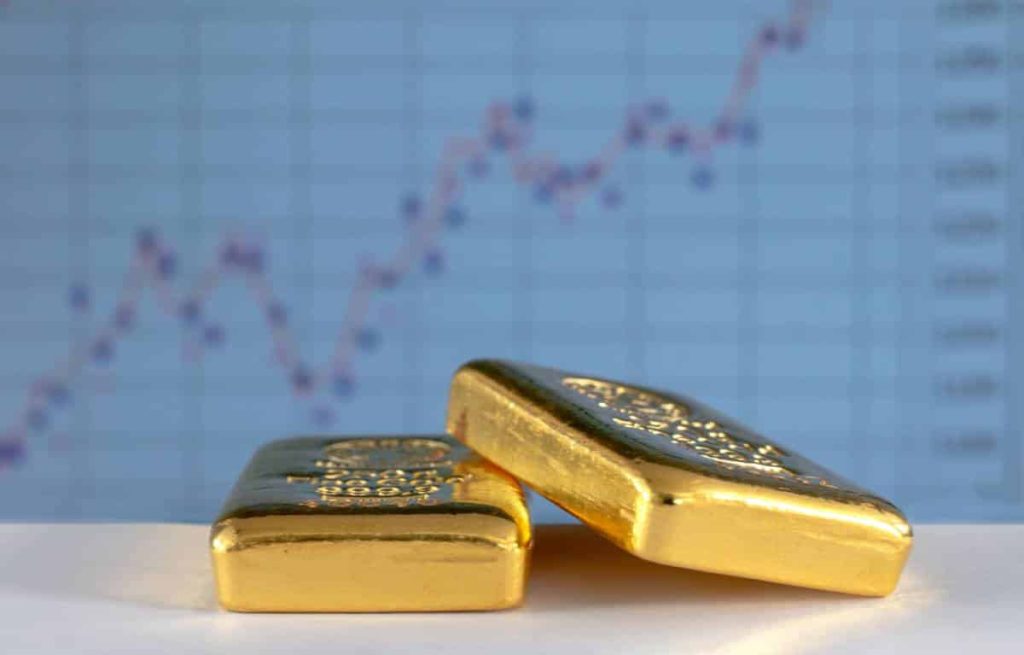Interest in gold continues to grow year by year. Indeed, when inflation causes currencies to lose value, the price of the yellow metal increases. It is considered by many to be a store of wealth and a safe buy. Especially since it can reach summits, depending on geopolitical and economic circumstances, especially in tense contexts. This was the case during the 1974 oil shock, or even during the attacks of September 11, 2001. Before investing in this precious metal, it is still important to know what influences its price. We talk about it in this article.
Summary
Gold prices : a little history
Before becoming the sought-after financial asset as we know it today, gold has evolved with our history. It is in the year 500 BC. AD that the first gold coins were minted. They have been used as currency since antiquity.
Thus, it was linked to the price of wheat with the Phoenicians, to that of silver with the Persians and the Greeks, before becoming the benchmark of the Roman monetary system. At the end of the Middle Ages, gold coins symbolized the wealth of France, notably with the famous Louis d’Or.
After the Revolution, gold was worth 1,550 times more than silver. But due to the depletion of reserves and the weakness of the world economy after the two wars, gold currencies were no longer convertible.
Today, the price of gold is no longer set by the state as before, but it is a function of supply and demand : before acquiring this precious metal and discovering the price of gold, it is therefore important to be well informed.

Who is responsible for setting the price of gold?
Gold is an asset listed on stock exchanges around the world. In Europe, it is the LBMA (London Bullion Market Association), a private actor, which determines the price of gold. It is the largest gold trading market in the world. It generates around 75% of the over-the-counter market.
The LBMA brings together international banks such as SBC, Barclays, Goldman Sachs, Bank of China, Morgan Stanley and Toronto Dominion Bank. But it also has mining companies, jewelry manufacturers, refiners, and gold coin traders. It is therefore an authority figure for investors in the yellow metal.
These different players communicate the cost of buying and selling to the LBMA in real time. The gold price is regulated in function and it is revised twice a day.
Factors that cause the price of gold to rise or fall
It is generally the geopolitical and financial context that causes the upward or downward trends in the price of gold.
Interest rates set by central banks
When interest rates set by central banks rise, the price of gold tends to fall. Indeed, in this situation investors turn to other assets directly related to interest rates, and sell their gold to free up funds for other investment opportunities.
the interest rate set by the Federal Reserve is the most important, because it is the American Central Bank that acts as the key arbiter of world markets.
Supply and demand
Supply and demand vary over time. Certain festive events in India or in China increase the demand for gold by jewelers, pushing up prices. Indeed, the gold exchange is still a tradition for some populations.
When some countries are also starting to buy more gold than they sell to increase their government reserves, the price of gold is found to rise.
International conflicts
In international conflicts, investors use gold as a safe haven in the face of uncertainties, increasing the price.
This theory was verified, for example, during the Greek elections, during which the victory of Alexis Tsipras was feared because of his program very different from that of his predecessor.
Inflation
Gold is often used as a safe haven to protect against inflation and currency devaluation. While these fluctuate, gold remains stable over the long term, regardless of the political environment.
If investing in currencies seems risky, gold means low risk. Investors then buy more gold when the value of their currency or paper money goes down.
Unexpected events
Certain more unexpected events can also have an impact on the price of gold. This was the case, for example, during the subprime crisis. The consequences of the Covid-19 crisis are still to be qualified, because there is a lack of perspective. But despite the rising inflation, gold constitutes a solid and stable value, even in a context of crisis.
Changes in the value of the dollar
Even so, the values of the dollar and gold are correlated, since it is the dominant currency. So when the dollar goes up, gold tends to go down. The reverse is also valid.
Understanding Gold Price Charts
Like other financial products listed on the stock exchange, the price of gold is closely monitored by investors. There are thus graphs that can be viewed to know the quantities of gold exchanged per day, during the period of your choice.
But their understanding is not always easy for everyone. If this is your case, know that the vertical y-axis shows the price of gold in the currency that interests you. The horizontal x-axis shows the date to link the price of gold to a specific period.
Thanks to this type of graph, you can easily know the fluctuations of the gold price, from the 2000s to today.
Is gold still a good investment?
In a homogeneous economic period, gold is to be considered like any other financial asset with its advantages and disadvantages.
The advantages of gold
Over time, gold has proven to be a solid financial asset, despite economic crises of all kinds. When purchasing power falls, the value of the precious metal increases. In addition, due to continued high demand, it is still possible to resell physical gold quickly.
Gold has a security value, and the coronavirus crisis has demonstrated it to us again. Its purchase is therefore recommended to guard against future uncertainties. It presents itself as an alternative to the banking system and escapes state control. Its other advantage is that the greatest number can invest in gold, whatever the budget, or from one gram.
The disadvantages of this type of investment
However, it should be noted that outside of periods of economic stress, gold suffers from a lack of yield and growth. Its potential compared to other assets is limited.
However, gold has its place in an investment portfolio, if only in small quantities, for the sake of diversification. In times of inflation, it is advisable to increase this amount.
How to buy and sell gold?
There are several ways to trade gold:
- the physical purchase of gold, in the form of ingots or coins. This is the most traditional method, but also the most expensive, due to the cost of ownership, among other things. Due to low liquidity, transaction costs can also be high,
- purchase via Exchanged Traded Funds (ETF) or exchange traded funds. It is an instrument intended to follow the price of gold on the international market. It allows private investors to take advantage of lower transaction costs, in addition to being a quick and easy way to buy and sell gold,
- purchase through CFDs (contracts for difference), offering advantages similar to ETFs, in terms of costs and speed. It allows for a short or longer term in gold. However, it is necessary to analyze the market well so as not to suffer significant losses,
- the purchase and sale of shares of certain mining companies, which are related to the price of gold. It can be an interesting way to negotiate the price of gold, studying important criteria like production levels, profit margins, etc.
As you can see, there are many ways to buy and sell this precious metal. There is no right or wrong way, it all depends on the budget you have, your available time and your level of investment.
Read also : The impact of cryptocurrencies on the global economy





